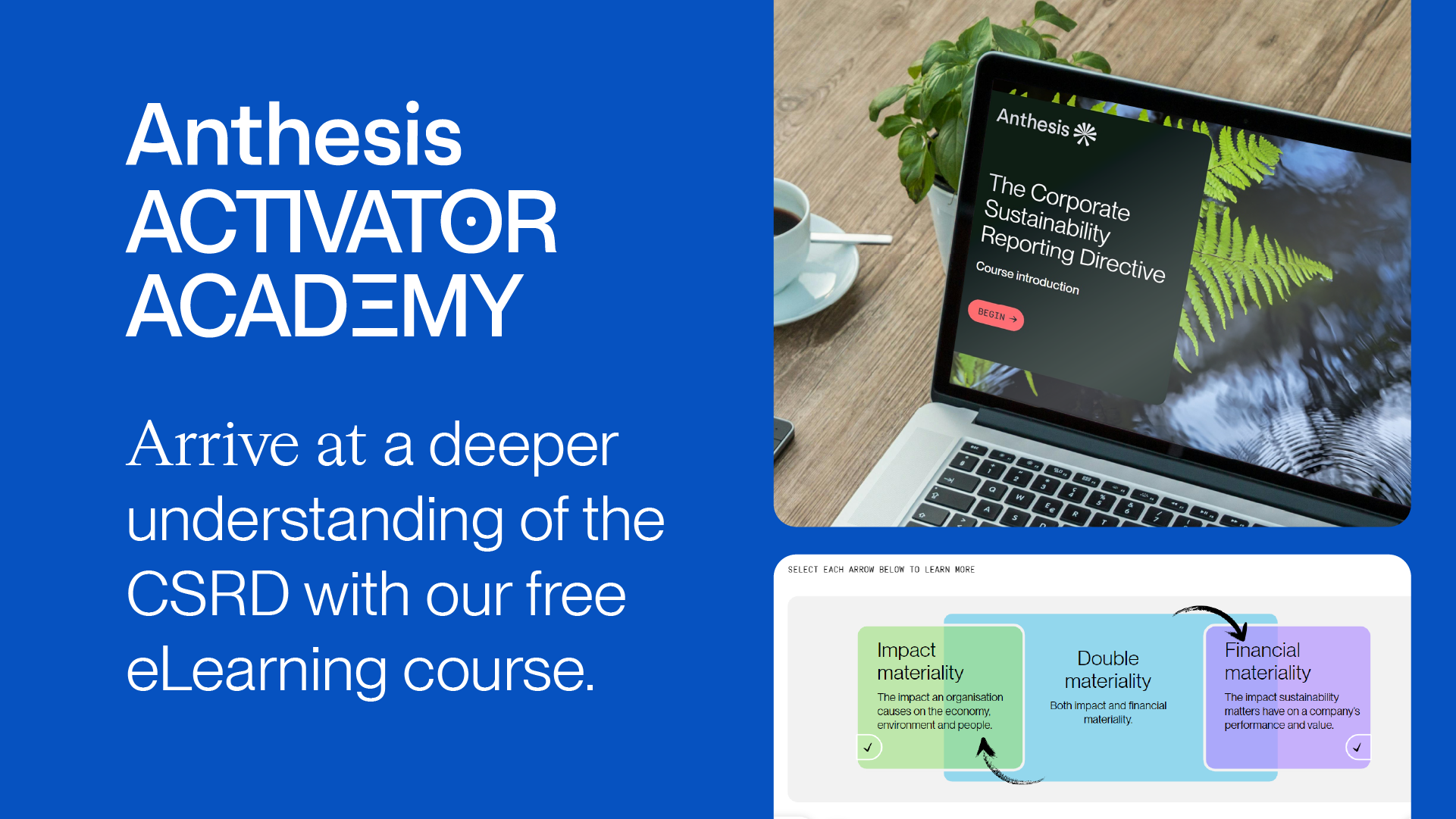
Contents
- General requirements – what is involved?
- Getting started – double materiality
- Who to involve?
- Why start now?
- How is Anthesis supporting you?
- Contact us
Share this article
Anthesis Technical Director for Mandatory Reporting, Chris Shaw, and Senior Consultant, Eilidh Morrison, share what businesses can expect from CSRD in 2024 and how to prepare, including what is required, how should you begin and who should you involve.
On the 31st of July 2023, the European Commission (EC) adopted the first package of European Sustainability Reporting Standards (ESRS) including cross-cutting ESRS 1 and 2, and standards across environmental, social and governance topics. For large EU Public Interest Entities and those already reporting under the Non-Financial Reporting Directive (NFRD) the countdown is now on to report against the CSRD for financial years starting on or after the 1st of January 2025.
For those businesses not meeting the above criteria, 2024 remains a critical year. We expect a number of developments from the EC, most crucially the deadline of 6th July 2024 for EU Member States to transpose the CSRD into national law. We also know that for certain large non-listed European entities, reporting against the CSRD will be mandatory for financial years starting on or after the 1st of January 2026, based on 2025 data.
So, what will be the practical requirements for a business beginning its ‘CSRD journey’ in 2024?
General CSRD requirements – what is involved?
All in-scope companies are required to make general disclosures about ESG, including how it is managed in their business, how ESG informs their strategy and business model, details of impacts, risks and opportunities (IROs) identified during the materiality process and how these are managed through policies, actions, metrics and targets.
There are processes that companies should follow that will help them to build the evidence base to make these disclosures, primarily through the double materiality assessment with input from ongoing sustainability due diligence processes and assessment of the value chain. These requirements are set out in the table below with a brief explanation of what they include and some practical first actions to consider.
Companies will need to disclose the sustainability information (the ‘sustainability statement’) in their management reports, which means that financial and sustainability information will be published at the same time.
This sustainability data will have to be submitted in a standardised digital format, to allow for easier checking and comparison in the European Single Access Point database. EFRAG announced in December 2023 that further guidance on this will be published in early 2024.
The submitted data and reporting will then be subject to “limited third-party assurance,” meaning that an independent auditor or assurance provider will need to evaluate the narrative and data.
| Requirement | What’s included? | Actions |
| Governance | – Details of how ESG is managed at the highest level of the business – Material matters addressed by supervisory bodies. – Use of incentive schemes to improve performance. | Start putting structures, for example, groups/ committees and terms of reference, in place now with practices for recording minutes and matters discussed. |
| Strategy and business model | – Resilience to risks Opportunities. – Sustainable economy transition. – Stakeholder interests and impacts on sustainability matters. – Strategy implementation. | – Revisit existing ESG strategy and goals, reflecting on challenges and solutions required. – Update and map business model and value chain. – Identify stakeholders the business may affect and those likely to review the report. – Set up and formalise processes for gathering views and interests of affected stakeholders. – Review data management processes. – Apply risk management or Enterprise Risk Management processes to sustainability information. |
| Double materiality | – Assessment of ESG topics from an impact and financial perspective. – Engagement with affected stakeholders. | – Review existing materiality practices and identify gaps to an ESRS-aligned approach. – Think about potential ESG impacts, risks and opportunities for your company. |
| Value chain | Assessment of IROs across upstream and downstream value chain, e.g. suppliers, distributors, consumers, investments etc. | Start mapping the value chain and identify potential sources of evidence to support determination of material IROs. |
| Due diligence | How due diligence has been considered in reporting and assessment of IROs. | Identify existing processes to identify, prevent, mitigate and account for impacts on people and the environment. |
| Impacts, risks and opportunities | – Details of ESG-related impacts, risks and opportunities identified during the materiality assessment – Potential and actual impacts a company has on the environment and people. – Financial risks and opportunities faced by the company, related to impacts identified or otherwise. | – Consider impacts the company has on people and the environment, including for example, emissions and purchasing practices in the supply chain. – Consider risks to the company as a result of impacts, e.g. potential fines from pollution-related impacts. – Consider opportunities for the company as a result of impacts, e.g. development of solutions with a reduced environmental impact. |
| Policies and actions | – Details of policies adopted to manage material sustainability matters. – Details of actions and resources in relation to material sustainability matters. | – Policies should outline how the company addresses material IROs, their scope and governance and any alignment with international frameworks. – Actions include those taken in the reporting year and any planned for the future with details of expected outcomes and their scope. |
| Metrics and targets | Details of metrics and targets concerning material sustainability matters. | Ensuring transparent calculation and reporting methodologies aligned to a basis of preparation that an independent assurance provider can assess. |
Getting started on double materiality
One of the first steps towards aligning with CSRD reporting requirements is completing a double materiality assessment – the process by which a company identifies its most material ESG matters from an impact and financial perspective. The outputs of this process provide the evidence base for what is to be reported in the sustainability statement and should inform the company’s strategy moving forward.
Who should you involve?
Where assessment of material issues has previously been driven by stakeholder views, EFRAG encourages the use of data where possible to identify evidence-based impacts, risks and opportunities for a company. That said, the views and interests of stakeholders are still fundamental to the identification, assessment and management of material issues.
While there is no prescribed approach for stakeholder engagement as part of CSRD, there is an expectation for companies to engage with stakeholders that may be affected by their activities – from workers across operations and the value chain, to communities and consumers. Views and interests of these groups should be collected on an ongoing basis through due diligence practices, with findings pulled into the materiality process where relevant.
To get started, those responsible for compiling their CSRD report should look to engage the following groups:
- Investors, business partners and civil society – Companies should consider the perspectives of those who may use the sustainability statement, including these groups, to understand the issues they deem most important.
- Finance and risk functions – To corroborate evidence of the materiality of different ESG matters, companies should draw on the expertise of finance and risk functions – not least because the sustainability statement is published alongside the financial statement in the management report, but also as companies are required to assess risks and opportunities for the business from a financial perspective, these functions will need to be involved in setting thresholds for what is to be deemed material.
- Auditors – With assurance requirements now a core part of ESG reporting, it is recommended that auditors used by the company are involved in the process as early as possible to ensure expectations and methodology are agreed and transparent.
- Legal advisors – We also recommend that companies engage with their legal advisors at the beginning of their journey to confirm specific reporting requirements.
Why start now?
The first round of companies will have to publish their first disclosures in 2025, reporting on 2024 data. To report accurately and efficiently, companies should have systems set up now to monitor metrics that fall under material topics. For companies that come later, there is still some time to get these processes set up, if they haven’t been already.
The final stage in implementing the CSRD is for EU member states to transpose the requirements into national legislation with limited potential for modification. Countries have a deadline of early July 2024 to do so, and France has taken the lead, having implemented in December 2023.
As a reminder, penalties for non-compliance can include fines and prison time so C-suite, finance and legal teams of obligated companies should be focusing on the realities of reporting requirements now. These penalties will be clearer once EU member states transpose the requirements into legislation by July 2024. As a guide, French authorities have confirmed fines for various infringements of up to €75,000 accompanied by potential prison time.
How can Anthesis support you?
The introduction of the CSRD arguably marks the most significant change to date in corporate sustainability reporting, and we are here for you to help with the transition. Anthesis offers solutions that give you the information and learning you need, help you to analyse your needs for change, and support you in implementing that change.
Our approach is two-fold: first, to prepare your organisation for compliance, focusing on internal understanding and the essentials of reporting. Secondly, perhaps more important, we empower your organisation for long-term success, uncovering the value and opportunities for your business, beyond regulatory requirements.

We are the world’s leading purpose driven, digitally enabled, science-based activator. And always welcome inquiries and partnerships to drive positive change together.





